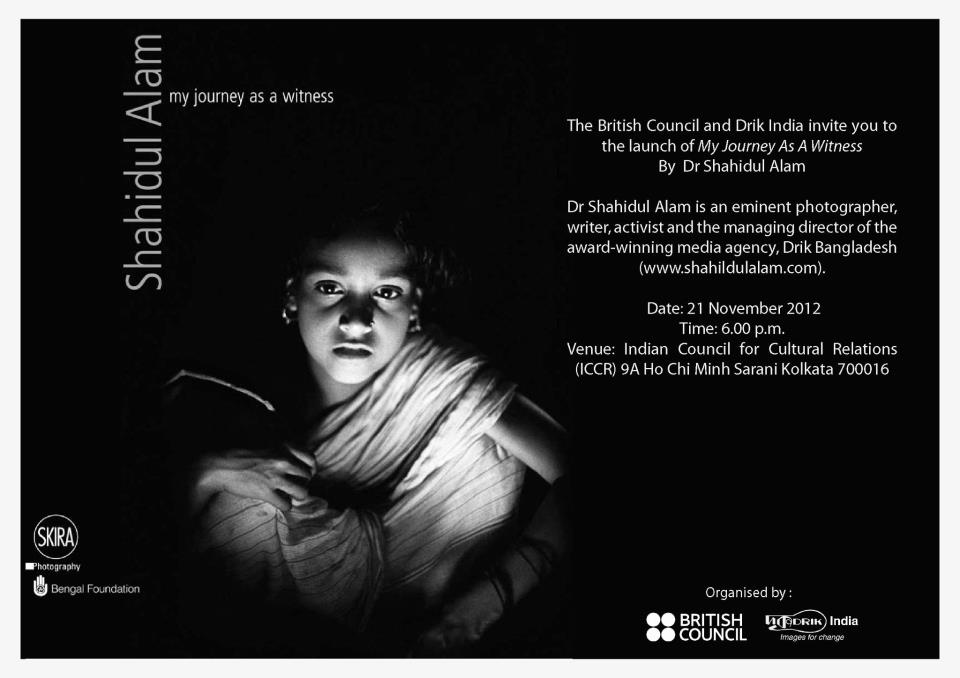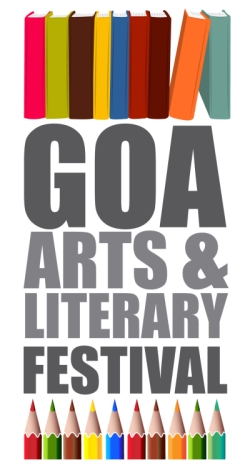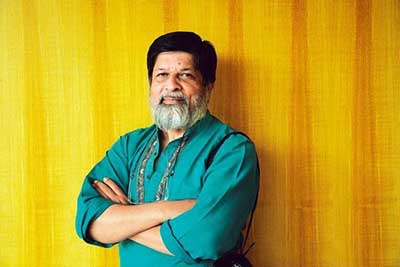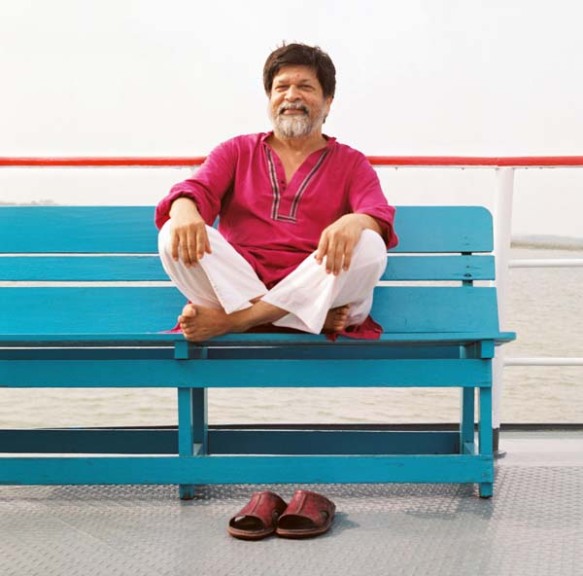Tag: my journey as a witness
Upcoming events

British Council and Drik India cordially invite you to the launching of the book by Dr. Shahidul Alam ? My Journey As A Witness? followed by lecture presentation of the artist.
Dr. Shahidul Alam is an eminent photographer, writer, activist and the Managing Director of the award winning media agency Drik Bangladesh.
Date: 21 November,2012
Time: 6- 8 pm
Venue: Jamini Roy Gallery, 3rd floor, Indian Council for Cultural Relations (ICCR), 9A Ho Chi Minh Sarani, Kolkata 700 016 ( Opposite to US Consulate)?? with?Shahidul Alam.
Review of My journey as a witness by John G Morris

Shahidul Alam by John G Morris in "La lettre de la photographie"
Friday 29th June 2012 La Lettre de la photographie.com









I regard?My Journey as a Witness?by?Shahidul Alam?as the most remarkable book by a single photographer since a messenger brought me a first copy of The Decisive Moment by Henri Cartier-Bresson in 1952. It is not that the two books should be compared, although they are approximately the same weight.
My Journey as a Witness is entirely different. It is an angry book, deliberately provocative. It too has many beautiful, meaningful images, but it is a book that must be read. It is a book that will break your heart.
Shahidul Alam was educated in the West, but he is a man of the East. As a teenager he witnessed the war that gave birth to his country, Bangladesh, in 1971. This book is a kind of diary of his career, which began briefly in London but now embraces the world.
His passion is to show ordinary people as they truly live and work, not as they are seen by what he calls the “dominant cultures” of the West.
Alam thinks most people in the world are being short-changed. He thinks photojournalists can do something about that. To assist them he has created an agency called Drik (Vision) in Bangladesh; a website, banglarights.com; and a brand, MajorityWorld.com. He also founded Pathshala, the first South Asian school of photography, which sponsors biennial international meetings, ? la Perpignan.
Alam’s ambition is not only to transform photography but to transform the world. He passionately argues for true world government, government by the majority of all peoples, not just dominance of the superpowers
I happen to agree with much if not most of what he says. Read the book and decide for yourself.
John G. Morris:?Journalist?John Godfrey Morris?(1916) has spent a lifetime editing photographs for magazines and newspapers, working with hundreds of photographers, among them the great names of 20th century photography.[1]
My Journey as a Witness – Shahidul Alam
Publisher: Skira
Edited by Rosa Maria Falvo
Introduction by Sebasti?o Salgado
and Preface by Raghu Rai
Hardcover – 224 pages
ISBN-13: 978-8857209661
Product Dimensions: 9.8 x 1 x 11.3 inches
Art as a Witness
Shahidul Alam to speak at the Colombo Art Biennial : Art as a Witness
An extraordinary artist ? eloquent with words and images ? Shahidul Alam is a photographer, writer, activist and social entrepreneur, who was profoundly influenced by inequality in Bangladesh, his country and the liberation war. He left a career in science in the west to pursue a life in photography challenging oppression and imperialism in all its forms. Attacked, arrested, and threatened with death, Alam has built what many consider to be the finest photography school in the world, an award winning agency, and the world?s most demographically diverse photo festival. Widely celebrated, Alam claims as his achievements not the awards he has won or the impressive list of exhibits, but the people he has trained and the lives he has transformed. Continue reading “Art as a Witness”
Eduardo Santiago's Reviews > Shahidul Alam: My Journey as a Witness
by?Shahidul Alam,?Rosa Maria Falvo?(Editor)

Recommended to Eduardo by:?Ginger
Painful to read. Troubling… but beautiful and inspiring as well. Alam comes across as deeply bitter, but unlike the rest of us he uses that to make this world a better place. Through his photography, his words, his actions, he brings truths to light. Beauty, too.
This is not a coffee table book. It’s not even mostly a photography book. It’s … autobiography? Geopolitical venting? Self-congratulation? Those but also much more. From my privileged first-world position it’s difficult to understand this book in context, to know where Alam is coming from. It’s easy to accept his perspective, to be temporarily outraged, and ultimately to do nothing because the third world (?Majority World?, as Alam insightfully calls it) is so remote.
Despite that, despite Alam’s occasionally difficult prose, I think this is a book worth reading and absorbing. A perspective that may be new to many of us. A reminder of so much that still needs to be fixed in this world, and that there are people fighting to fix it.
Shahidul Alam in Amsterdam
BANGLADESH PHOTOBOOK READER PRIZE
Subscribe to ShahidulNews
Shahidul Alam?s ?My Journey as a Witness?: book excerpt and giveaway
Head on down past the fascinating opening essay from the book excerpted below, put together by curator and writer Rosa Maria Falvo, to find out how to win!
 Shahidul Alam, ‘Ilish fishing’. Image from book. ? Shahidul Alam.
Shahidul Alam, ‘Ilish fishing’. Image from book. ? Shahidul Alam.
Impossible is nothing
Few Westerners have any understanding of Bangladesh?s complicated history or even know exactly where it is on a map. And fewer still have experienced what this country has to offer. I first went there in 2008, travelling to Dhaka from Kolkata by bus across the Indian-Bangladeshi border at Benapole, and after our first ?luxury? bus ripped a hole in its undercarriage as the driver forced the ferry ramp prematurely, we jumped onto another making its way into the belly of a night ferry, crossing the Padma (?lotus?) River, the main channel of the great Ganges (Ganga) River originating in the Himalayas. Immediately surrounded by a smiling and curious crowd, it felt exhilarating to be suddenly thrust into the enduring dynamism that is daily life in Bangladesh. Washing over my vague but cemented notions of disaster and poverty, the reality for me was inspiring, within the chaos and calm combined. I have since travelled southwards to Chittagong?s great seaport, and then north into Bogra, through Dinajpur, visiting temples and monasteries, onto Rangpur, stopping for tea with indigo farmers, heading west to Thakurgaon, giving way to elephants on the village roads, and across India on our way to Biratnagar, Nepal. Increasingly, I am struck by the pervading ?impossible is nothing? approach to life here, and by the magnanimity of the people of Bangladesh.
We met a cheeky bearded man on a bicycle, busily navigating his schedule in a city that relentlessly thwarts any plans one might have to move promptly from A to B. To describe Dhaka?s serious traffic problems is to begin with sheer understatement, and yet the locals carry on undeterred. We walked into his photo agency full of energetic youth, with an obvious respect for their teacher, in positions of responsibility that showed they belong.
Working alongside Shahidul Alam is an extraordinary experience. There is no self-righteous arrogance, impatient hustling, or delusions of grandeur. Here is a true humanitarian; honest, hard-working, and committed to the cause; a talented man who is loved by many in a social, political and environmental system that is bursting at the seams; one that needs overhauling; and one he has been intimately engaged with for over thirty years. In the most unlikely conditions, with the odds (and sometimes the guns) pointed squarely against him, he manages to get the job done with a centeredness that inspires others to do the same. And what exactly is that job? Born from a simple premise and pitted against a seemingly impossible challenge, he dares to turn perceptions around and broaden our thinking, to rebalance the dynamics of communicative power, to redistribute imagery that impacts contemporary culture, and to respect geographic diversification. Not one to shy from the harshest realities in his country, which are best understood by those living them, Alam is educating for a new vision, which enlightened photography aspires to convey. If we consider the classic vehicles of social control, what happens when multinationals and politicians representing eight countries monopolise a world whose ?majority? often stands like an elephant tied to a rope? This majority will inevitably find its strength and something practical and peaceful can be done to help recognise it.
Shahidul Alam in conversation with Ranjit Hoskote at Goa LitFest
7:00 pm to 8:00 pm
Tuesday 20th December
Goa Literary Festival
My Journey as a Witness
Shahidul Alam in conversation with Ranjit Hoskote
Goa Arts and Literary Festival Dec 17-21

2011-11-25
The 2nd Goa Arts and Literary Festival is meant to coincide with the 50th anniversary of Goa’s liberation after 451 years of colonial rule. It will reflect on the idea of India as reflected through the perspective of cultures, communities and writers of the country. It is hosted by the International Centre Goa from December 17-21.
The festival will touch upon Diaspora, on the Goan and other Indian migrant communities across the world which retain different ideas about what being Indian means; North-East of India and its art, music and literature. The festival will celebrate music, painting and photography, poetry, journalism and publishing, debates, discussions and book-releases: from 17-21 December. Local, national and international delegates will be attending.
Exactly 50 years after the historic days when Indian troops conquered, and annexed Goa. It was another dramatic moment in history for this tiny territory. Each day of the Festival will recall 1961, featuring historians and witnesses to the sensational events as they occurred, as well as lectures, special book releases, and panel discussions about the Goan experience of the Estado da India, quite different from much of the rest of the subcontinent’s experience with the British Raj.
The 2011 Goa Arts and Literary Festival will celebrate creative excellence across India, with a special focus on Goa and its Diaspora. As with the inaugural edition, there will be prominent daily showcases for the best contemporary poetry from across India, and for the extraordinary writers and musicians of the North East.
Events such as this Festival will be held annually so that the quality of the Festival is enriched and enhanced every year by involving more and more people and their ideas and the image of Goa in people?s mind is of a more vibrant cultural and intellectual destination.
Participating Authors:
Aatish Taseer, Abhay Sardesai, Amitav Ghosh, Anand Patwardhan, Anjum Hasan, Aniruddha Sen Gupta, Bhalchandra Nemade,Bilal Tanweer,Charles Correa,Chiki Sarkar, C P Surendran, Cyril Almeida, Deborah Baker, Desmond L Kharmawphlang, Eunice de Souza, Fatima Bhutto, Gulzar, H M Naqvi, Jai Arjun Singh, Jeet Thayil, Jerry Pinto,Jonathan Shainin, Kiran Nagarkar, Kjell Eriksson, Kynpham Sing Nongkynrih, Manohar Shetty, Mamang Dai, Meena Kandasamy, Mitra Phukan, Mohammed Hanif, Mridula Garg,M. T. Vasudevan Nair, Naresh Fernandes, Nirmal Kanti Bhattacharjee, Pablo Bartholomew, Pavan K Varma, Raghunath Mashelkar, Ranjit Hoskote, Robin Ngangom, S. Anand, Sadia Dehlvi, Saeed Akhtar Mirza, Samar Halarnkar, Sidharth Bhatia, Shahidul Alam, Shailaja Bajpai, Shehan Karunatilaka, Sheen Kaaf Nizam, Sivasankari, Sonia Faleiro, Sukrita Paul Kumar, Sunil Khilnani, U.R. Ananthamurthy, Urvashi Butalia,Temsula Ao,Teju Cole, Vishwas Patil, Zac O’Yeah
Participating Artists and Performers:
Dr. Alka Pande, Atul Dodiya, Durgabai Vyam, Gulam Mohd Sheikh, Himanshu Suri, Lou Majaw, Luis Gumby Pinto, Subhash Vyam,Dr. Subodh Kerkar, Suresh Jayaram, Suresh Jayaram, Vijay Iyer
Bangladeshi photojournalist Shahidul Alam?s first UK retrospective ? picture feast
From Art Radar Journal
BANGLADESH PHOTOGRAPHY LONDON GALLERY SHOW
The first UK retrospective of works by internationally renowned Bangladeshi photographer and social activist Shahidul Alam is on at London?s Wilmotte Gallery until December 2011.?Art Radar brings you a selection of portraits and accompanying wall texts from the exhibition.
Click here to read more about the artist and the exhibition, called ?Shahidul Alam: My Journey as a Witness?, on Wilmotte Gallery?s website.

‘Nurjahan’s father’ (portrait), Chatokchora, Sylhet, Bangladesh, 1994. ? Shahidul Alam.

‘Ali Zaman’ (portrait), Chakkar Bazaar, Kashmir, Pakistan, 2005. ? Shahidul Alam.
 Continue reading “Bangladeshi photojournalist Shahidul Alam?s first UK retrospective ? picture feast”
Continue reading “Bangladeshi photojournalist Shahidul Alam?s first UK retrospective ? picture feast”
Win a copy of "My Journey as a Witness"
Subscribe to ShahidulNews
Bangladeshi photojournalist Shahidul Alam?s first UK retrospective ? picture feast
The first UK retrospective of works by internationally renowned Bangladeshi photographer and social activist Shahidul Alam is on at London?s Wilmotte Gallery until December 2011.?Art Radar brings you a selection of portraits and accompanying wall texts from the exhibition.
Click here to read more about the artist and the exhibition, called ?Shahidul Alam: My Journey as a Witness?, on Wilmotte Gallery?s website.
 ‘Nurjahan’s father’ (portrait), Chatokchora, Sylhet, Bangladesh, 1994. ? Shahidul Alam.
‘Nurjahan’s father’ (portrait), Chatokchora, Sylhet, Bangladesh, 1994. ? Shahidul Alam.
It was reported in the papers as suicide. On 10 January 1993 Nurjahan, a woman in her twenties from a struggling peasant household from the Maulvi Bazar district of north-east Bangladesh, was found dead from poisoning at her parents? house in the village of Chatokchora.
Nurjahan Begum, 7th among 9 daughters, had been married five years before the incident. However, her husband abandoned her and she returned home to live with her parents. Later, her parents arranged another marriage for her, but since polyandry is forbidden by Muslim law, it was necessary to discover whether her first marriage had been properly dissolved. Nurjahan?s father consulted the village imam (religious leader), who declared that she was free to marry. However, he revoked this later and claimed that the marriage was illegal because the first still stood. A shalish (village council for settling disputes and trying offending villagers) met to judge whether Nurjahan and any of her family members had broken the law. The shalish found Nurjahan guilty of fornication, on the grounds that she was still married to her first husband; after debating the punishment, it decided that 101 pebbles should be thrown at Nurjahan and her second husband.
Pebbles were preferred to stones since the intention, reportedly, was to shame the couple rather than hurt or kill them. Nurjahan?s parents were also to be punished; the shalish decreed that they should be beaten with a broom. Nurjahan was made to stand in a hole that was then filled, half burying her, to receive her punishment. As she did so a member of the shalish approached her and castigated her for the shame she had brought on her family. She was not fit to live and should kill herself. Nurjahan was found dead the next day.
Rahnuma Ahmed, public anthropologist and writer
 ‘Ali Zaman’ (portrait), Chakkar Bazaar, Kashmir, Pakistan, 2005. ? Shahidul Alam.
‘Ali Zaman’ (portrait), Chakkar Bazaar, Kashmir, Pakistan, 2005. ? Shahidul Alam.
In 2006 I returned to the Siran Valley in Kashmir eight months after I had first been there photographing the advent of winter. The land was full of new crops, but many of the homes were still to be rebuilt. Ali Zaman and his friends had gathered in a tea stall. Old friends chatted over a cup of tea. Zaman was one of many who had thought he was witnessing ?Keyamat? (doomsday). The phone booth outside, was a telephone under the open sky. A barber had set up shop amidst the rubble. School children sat around a blackboard propped up in a field. People got on with their lives.
Shahidul Alam
 ‘Horipodo? (portrait), Shondeep, Bangladesh, 1991. ? Shahidul Alam.
‘Horipodo? (portrait), Shondeep, Bangladesh, 1991. ? Shahidul Alam.
The cyclone shelter was packed with people, mostly women and children, some crying, others screaming. Amid the chaos, came a loud knock. We struggled to open the door against the wind. The night sky was bearing down on the small gap we had made. A man pushed his way in as we struggled to lock the door again. He was a strong burly type, but he was shaking. ?Give me a biri? he said. I got angry. ?Can?t you see what?s happening here? The state people are in? And you want a smoke?? He wasn?t cruel, but his stare was cold. ?agaro jon re puita aisi. biri de.? (I?ve buried eleven. Just hand me a biri).
Shahidul Alam
 ‘Ship breaking worker’ (portrait), Rahman Yard, Chittagong, Bangladesh, 2008. ? Shahidul Alam.
‘Ship breaking worker’ (portrait), Rahman Yard, Chittagong, Bangladesh, 2008. ? Shahidul Alam.
Development isn?t simply about money. What about developing mutual respect? Enabling equitable partnerships? Providing enabling environments for intellectual exchange? What about creating awareness of the underlying causes of poverty? These are all integral parts of the development process. When all things are added up, cheap images providing clich?d messages do more harm than good. They don?t address the crucial issue: poverty is almost always a product of exploitation, at local, regional and international levels. If poverty is simply addressed in terms of what people lack in monetary terms, then the more important issues of addressing exploitation are sidelined.
Lacking the advantages of our Western counterparts, image-makers in the Global South have had to rely on ingenuity and making-do in order to move from being fixers, to authors in their own right. We have had to be pioneers. The Sanskrit word ?Drik? means vision, inner vision, and philosophy of vision. This vision of a more egalitarian world, where materially poor nations have a say in how they?re represented, remains our driving force.
Shahidul Alam
 ‘Hemayetpur peep hole’ (portrait), Hemayetpur, Pabna, Bangladesh, 1994. ? Shahidul Alam.
‘Hemayetpur peep hole’ (portrait), Hemayetpur, Pabna, Bangladesh, 1994. ? Shahidul Alam.
In 1994 Dr A.K.M. Abdus Samad, director of the Hemayetpur mental hospital in Pabna, Bangladesh, was pragmatic ? ?An average of 2 percent of all populations is schizophrenic and of course there are many other mental ailments. In this country of 130 million, we have one hospital with 400 beds. What do you expect? The government?s allocation for food is 18 taka per day (about 45 US cents at the time). Many mental patients are hyperactive and require more food. A good portion of that 18 taka goes to the contractor. The remainder has to provide three meals a day. So what can I do? I make sure they get plenty of rice. That way at least their stomachs are full. We have little money for drugs and virtually no staff for counselling, so we keep them doped. Then they don?t suffer as much.?
Shahidul Alam
 ‘Champa: Naxalite series’ (portrait), Jessore, Bangladesh, 1994. ? Shahidul Alam.
‘Champa: Naxalite series’ (portrait), Jessore, Bangladesh, 1994. ? Shahidul Alam.
The Naxalite movement was going to liberate them. It was a fight against oppression. Champa would dress up as a boy to sneak into the party meetings and listen to the speeches. She was one of many who left home to join the party. This movement was different. Women could be leaders, and take part in battle. Weddings were simple affairs. With a hand shake and a salute. Champa had been a leader, but when the party disbanded, they had nowhere to turn to. They had burnt their bridges.
Shahidul Alam
 ‘Girl in wheat field’ (portrait), Bangladesh, 1997. ? Shahidul Alam. Continue reading “Win a copy of "My Journey as a Witness"”
‘Girl in wheat field’ (portrait), Bangladesh, 1997. ? Shahidul Alam. Continue reading “Win a copy of "My Journey as a Witness"”



